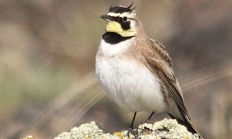Search myodfw.com
From the eastern flanks of Crater Lake National Park through ponderosa pine forests to the nationally-renowned Klamath National Wildlife Refuge, there is something for every bird hunter in south central Oregon.

Find maps, boundary information and the percent public land for the Maupin Unit.
Find maps, boundary descriptions and the percent public land for the McKenzie Unit.
Find maps, boundary information and the percent public land in the Upper Deschutes Unit.
Find maps, boundary descriptions and the percent public land for the Warner Unit.
Wide open spaces generally surround these sparrow-sized, ground dwelling birds. The upperparts are mostly brownish and the underparts are generally buffy with varying amounts of yellow on the throat. There is black on the breast and side of the head, but the most unique features are small black "horns." Females and immature birds are duller. Interesting behavior includes aerial displays and "flight songs" during courtship, and the propensity to forage and loaf along dirt and gravel roads. In western Oregon, it breeds in small, scattered populations throughout the Willamette Valley, with concentrations in the central valley on and near Basket

Find maps, boundary descriptions and the percent public land for the Klamath Falls Unit.
Find maps, boundary descriptions and the percent public land for the Whitehorse Unit.
Find maps, boundary descriptions and percent public land for the Fossil Unit.

The coyote is a typical canid intermediate in size between the foxes and the gray wolf. The pelage of the coyote is grayish, buff, pinkish cinnamon, or brownish, or a combination of those colors, often overlain by blackish tipped hairs on the ears, muzzle feet, and dorsum. The lips and eyelids are black, accentuated by contrasting borders of white fur. The underparts are paler than the remainder of the body. Considerable variation in color and markings of coyotes is evident among individuals and regionally east and west of the Cascade Range. True albinos with pink eyes and pink foot pads

Oregon’s big game are managed by wildlife management units, particularly for controlled hunts, so get familiar with the boundaries where you want to hunt. Hunters in Oregon can access millions of acres of public land open to hunting ( national forests, BLM land, state forests, wildlife areas) plus many private lands open through Oregon’s Access and Habitat program. See www.oregonhuntingmap.com to find a place to hunt.

Find maps, boundary information and the percent public land in the Evans Creek Unit.
Find maps as well as boundary and the percent public land for the Metolius Unit.
Find maps, boundary descriptions and the percent public land for the Owyhee Unit.
